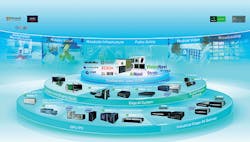Advantech accelerating edge innovation
Beginning with its pioneering work some four decades ago to bring the IBM PC architecture to industry and other “non-desktop,” embedded applications, Advantech has long innovated at the converged intersection of IT and operational technology. Today we call it the edge, where a combination of pervasive connectivity and powerful compute solutions are enabling applications undreamed of even a few years ago.
Indeed, Advantech was first to call this revolution the AIoT, recognizing the potential of artificial intelligence (AI) deployed at scale across the Internet of Things (IoT). To learn more about how Advantech continues to push the envelope of what is possible at the edge—and up to the cloud as well—Control caught up with Jerry O’Gorman, leader of the company’s Industrial IoT business in North America.
Q: Whether you call it the AIoT or Industry 4.0, the digitalization of industry is well underway. When it comes to the edge, what technologies are having the greatest impact on the solutions delivered today, and what technologies should our readers in the industrial space keep an eye on?
Industrial IoT Business Leader,
Advantech North America
A: Across the industries that we serve, we’re seeing artificial intelligence together with video inputs at the edge as a particularly powerful combination. AI is allowing the camera to emerge as a ubiquitous sensor, replacing conventional sensors that we might have used in the past. Warehousing operations as well as transportation control systems are two niches where video AI is proving particularly powerful. 5G networks are also coming to the fore, as industry seeks to deploy more lightweight gateways and connectivity, but preserve the low latency that's one of the main drivers for edge computing in the first place.
A bit longer term, companies are developing software suites that provide what we refer to as the hyper-converged, cloud-optimized edge. They’re seeking to satisfy the requirements of factories and industries to preserve elements of an orchestrated solution on-premise for latency and security issues, yet distance the customer from the complexity required of traditional on-premise solutions. The idea is to deliver complete solutions that are orchestrated from the core, with the ability to do upgrades, and maintain one’s edge infrastructure as an extension of the cloud, but in a very automated, service-delivered manner.
Q: In this day and age, both end users and industrial machine builders increasingly seek to purchase integrated solutions for automation needs rather than system components—and that certainly applies at the edge. Can you describe how the shift from components to more integrated solutions began for Advantech?
A: This certainly has been ongoing for some time, as customers really are more interested in outcomes than the particular pieces of technology that make them possible. As a very broad-spectrum hardware supplier, Advantech was drawn early on into partnering with software providers to deliver comprehensive, integrated systems for our mutual customers. That approach has been fundamental to Advantech’s expansion in various markets.
We've always accompanied major regional sales development efforts with corresponding support operations, such as backup centers capable of configuring complete systems, not just from a hardware perspective, but sometimes preloading images of our partners’ software for our customers’ convenience. It’s all about outcomes and convenience for the customer.
Six years ago, Advantech started to invest significantly in areas of software development ourselves. And today, we've got a number of products that are capable of delivering complete solutions within various verticals, such as operational efficiency applications in factory automation and energy measurement and dashboarding. These solutions are more actively deployed in Asia because the development teams and engineers are based in that region. In North America and Europe, we leverage relationships with a range of ecosystem partners to deliver those types of integrated solutions to customers.
Q: As you’ve gathered ecosystem partners that specialize in software and other complementary technologies, how have the business models evolved?
A: We’re proactively forging formal relationships with software companies here in the U.S., and sometimes a particular project or solution involves more than one eco partner. Sometimes it’s application developers as well as providers of software and hardware infrastructure that all complement our foundational compute hardware. Sometimes the relationships are quite complex, including, for example, a cybersecurity element as well as an application enablement IoT platform together with our hardware. Those kinds of partnerships are actively delivering solutions to customers today.
Q: Early last year, you announced the formation of the AIoT Ecosystem fund in conjunction with Momenta Ventures to grow and nurture potential contributors to the AIoT and Advantech solutions. How has this worked out so far? Have you found success with this model, or is it too early to tell?
A: While many of the fund’s investments have been with early-stage startups with an eye on longer term returns, we can already point to a number of co-creation project wins—even from a revenue standpoint.
What I think is really interesting is the process we use to look at ways to co-create with our product divisions, to actively identify ways to collaborate with those companies on projects, or to meet customer needs in a collaborative fashion. We approach that in a formal manner, and the potential to co-create or collaborate to meet customers’ needs becomes a fundamental aspect of our evaluation criteria. It's not just the founders, the strength of the team, the technology we’re looking at. A focus on co-creation or collaboration opportunities that capitalize on our mutual interests and abilities really ends up being a win-win-win. We can bring an immediate return to us, to our partners, and to our customers, too.


